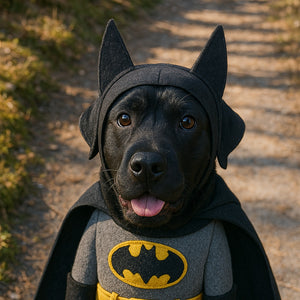
🐾 You called out, but your dog still hasn't returned? This guide will transform your walks!
Learning to recall a dog is one of the most important tasks facing every responsible owner. It's not just a matter of obedience, but above all, safety – both for the dog and the environment. The recall command is like an emergency brake – it can decide the health, or even life, of a pet in an emergency. Moreover, it gives the dog freedom and the owner peace of mind.
Imagine a walk in the woods where your dog can freely explore, knowing that with a single word, he'll return to you with trust and joy. Or the moment the leash slips from your hand, and despite temptation, your dog instinctively returns when called. These situations aren't the result of luck, but of well-executed training.
In this article, we'll present a comprehensive guide to helping you effectively train your dog to respond to the recall command. And no, this isn't a dry manual—it's a story about a process that can transform daily walks into a joyful and safe adventure. You'll learn how dogs think, how to build a relationship with them, and which techniques yield the best results—all based on practice, empathy, and mutual trust.

🐾 Why is cancellation so important?
Imagine a situation where your dog runs towards a busy street, another dog, or a person afraid of animals. An effective recall command can prevent a tragedy in such moments. It's the foundation of a responsible owner and the key to safe walks.
Recalls not only protect the dog's health and life, but also increases the owner's psychological well-being. Knowing that the situation is within their control at any time allows them to enjoy a stress-free walk. It's also proof of a relationship built on trust and mutual understanding.
Trained recall also gives your dog more freedom. Instead of keeping him on a short leash out of fear of escape, you can let him explore his surroundings, knowing he'll return when called. This means more joy for your dog, opportunities to explore the world, and better satisfaction of his natural needs.
It's also a skill that can save lives in unexpected circumstances—when a gate opens, the leash falls off, or the dog sees something that catches its attention. Responding to a command in a split second may be the only way to avoid danger.
But learning to recall is about more than just safety. It's also about building relationships and trust. A dog that happily returns to its owner knows something good awaits them there. It's a form of communication that results in calmer walks, less stress, and more shared adventures.

🧠 Understanding Your Dog: The Key to Effective Training
Before you begin training, it's important to understand how your dog perceives the world—its learning process, motivations, and limitations. Dogs don't think like humans. They operate primarily based on instincts and experiences, so it's crucial for their owners to empathize with their perceptions of reality.
Dogs learn through association and repetition. A key mechanism is conditioning – positive experiences associated with a specific behavior make the dog more likely to repeat it. Therefore, it's important that the recall command is always the same and associated with a reward, praise, or play.
For a dog, "come" isn't a straightforward command. For a command to gain meaning, it must be associated with a specific, attractive outcome. If each recall results in something pleasant, the dog will begin to perceive it as a worthwhile choice. However, if the command is ignored, inconsistent, or leads to unpleasant consequences (e.g., the end of play), the dog may stop responding.
Observing a dog's emotions is equally important. Fear, stress, or overexcitement can cause an animal to ignore a command—not because it's stubborn, but because its nervous system prevents it from focusing. A trainer or handler must be able to recognize these signals and adapt the training environment to the dog's abilities.
Understanding your pet's individual temperament is another important element. Some dogs are more receptive to training, while others require more patience. Motivation can vary – one dog might reward with a treat, another with a toy or praise. Choosing the right reward is key to success.
The foundation of effective training is empathy. When a handler sees the world from a dog's perspective, they learn to communicate better, avoid mistakes, and build trust. Recall isn't just a command—it's the result of a dialogue between human and dog, based on understanding, consistency, and positive emotions. When a dog begins to perceive that returning to its handler means something pleasant, it will begin to choose to return on its own—even in the face of temptation.

🎯 Step by Step: How to Teach Your Dog to Recall
1. Select the appropriate command
The most common commands are "come," "come," and "come back." It's important that they are short, clear, and always used in the same context. Make sure you say them cheerfully and enthusiastically.
2. Start in a quiet environment
Begin training in a distraction-free environment—your home or garden. Use a treat or favorite toy as a reward. A calm environment will help your dog focus on the task and more quickly understand the relationship between command and reward.
3. Gradually increase the difficulty level
Once your dog has mastered the command in a quiet environment, move the training to more distracting places, like a park or the street. Remember to always reward your dog for correctly completing the command—no matter how long it took. The important thing is that he returns.
4. Exercise regularly
Short, daily training sessions are more effective than long, sporadic exercises. Consistency and patience are the keys to success. Even a few minutes a day can yield great results if the exercises are performed with commitment and enjoyment.
5. Change rewards
To keep your dog motivated, it's worth varying the rewards. Sometimes it's a treat, other times it's play, petting, or praise. A personalized approach yields the best results – observe what motivates your dog most.

🚫 The most common mistakes and how to avoid them
Making mistakes when training recall is natural – it's a process that requires much trial and error, observation, and correction. Below, you'll find the most common mistakes that can ruin your efforts and cause your dog to stop responding to the command.
- Lack of consistency : Using different commands ("come here," "come on," "come here") or varying tones of voice can confuse your dog. Dogs respond best to repetition—one specific command said consistently will help them understand what you want.
- Too infrequent practice : If recall is practiced only occasionally, the dog won't learn the command. Regularity is key – daily sessions, even short ones, yield much better results than occasional training.
- Lack of rewards : Expecting your dog to come back "because it's the right thing to do" without offering rewards is a mistake. A dog comes back because it has a vested interest – a reward reinforces this behavior. The more attractive the reward, the stronger the association with the command.
- Introducing challenging environments too quickly : Recall training should be gradual. If your dog has just learned a command in the garden, you can't expect him to respond immediately in a crowded park. Introduce distractions gradually.
- Punishing for not coming : If your dog doesn't respond to a command and is punished, for example, by being scolded upon returning, they may stop coming altogether. Instead, reward every return—even if it's delayed. Every step toward the owner is a step in the right direction.
- Only recall in negative situations : If the "come" command always means the end of play, going home, or putting on the leash, your dog may start to avoid it. Therefore, also recall your dog in neutral situations to reward him and allow him to return to exploring.
- Impatience and frustration : Dogs can sense their owners' emotions. Frustration during training can reduce learning effectiveness and discourage the dog. Try to maintain a positive atmosphere – dogs learn faster when they feel safe and understood.
Being aware of these errors is the first step to eliminating them. Each one can be corrected – all it takes is patience, observation, and a willingness to learn, even on the human side.

🧩 Exercises to support learning to recall
In addition to the classic recall during walks, it is worth diversifying training with various exercises that not only reinforce the command, but also teach the dog to react in different situations, increasing its self-confidence and behavioral flexibility.
- Hide-and-seek : Hide in the house or garden and call your dog. When he finds you, praise and reward him. This game not only practices recall but also strengthens the bond and teaches your dog to focus on finding his owner.
- Play fetch with a command : Throw a toy to your dog and, before he reaches it, call him. This is a great way to teach him to give up and respond quickly to a recall, even when highly agitated. Fetch combines movement with controlled recall.
- Taking turns calling with others : Practicing with family members or friends is a great way to reinforce the command in a variety of contexts. People stand facing each other at a greater distance and take turns calling the dog, rewarding him for each return.
- Recall during distractions : When your dog is playing, sniffing, or talking with another dog, gently and enthusiastically call him back. If he returns, praise him profusely and reward him. This teaches your dog that it's worth giving up interesting stimuli for the sake of his owner.
- Using a training leash : A long leash allows for recall practice in an open area while maintaining control. It gives the dog a sense of freedom and allows the handler to react quickly.
- Elements of obedience with the "come" command : Practice combining the command with sitting or lying down after returning - this builds additional focus and increases the precision of the dog's reactions.
- Sudden recall during a walk : An unexpected recall during a casual walk (e.g., between trees, while playing) teaches the dog to react in different conditions and situations.
These exercises introduce variety, help reinforce the command, and make recall a natural reflex for your dog, not just a training exercise. The more often and joyfully your dog practices "come to me," the stronger his recall reflex will be.

🔁 Referencing in everyday life – examples of use
Recall isn't just a practice in controlled environments—it's a skill that finds application in real-world, often unpredictable, situations. Here are a few everyday scenarios where the "come" command can play a key role:
- Walking in the woods or park : Your dog is exploring the area and you want to call him back before he disappears from your sight or gets close to other animals.
- Lost leash or open gate : The leash slips from your hand, or your dog suddenly finds himself outside your property. An immediate recall can prevent him from escaping or entering the roadway.
- Encountering an unfamiliar dog : Before a confrontation or overexcitement occurs, you can call your dog to calm the situation.
- Approaching cyclist, runner or child : To avoid potential collisions and misunderstandings, call your dog to a safe distance.
- Temptation Recall : When a dog approaches food on the ground, a dead bird, or other “treasure,” the recall teaches him to give up the dangerous object.
- Guests visiting the house : The dog runs enthusiastically to the door – calling allows you to calmly welcome visitors and avoid chaos.
- Calling your dog to the car or carrier : Instead of chasing him around the driveway, just one command will make him happily approach the car.
Everyday life offers dozens of opportunities to practice recall. The more such situations you utilize for training, the more natural this command will become—for both you and your dog.
✅ What to do if the dog does not come back?
Even the most well-trained dog can sometimes fail to respond to a recall command. This is frustrating, but perfectly natural – it's important to remain calm and know what to do in such a situation.
1. Don't panic and don't scream
Yelling, being nervous, or chasing your dog can make the problem worse. Your dog may perceive your behavior as playful or, conversely, become frightened and run away even further.
2. Encourage, don't scare
Use a cheerful tone of voice. Kneel down, spread your arms, show a toy or treat. Do something attractive – hide, pretend you've found something – many dogs come back out of curiosity.
3. Do not punish your dog when you return
If your dog returns after a few minutes, don't show anger. Even if you're angry or upset, your dog needs to associate his return with something positive. Any punishment can discourage him from responding in the future.
4. Apply the sudden retreat principle
Instead of running after your dog, turn around and start walking away. This often creates a surprise effect – the dog, seeing you leaving, starts following you.
5. Analyze the situation afterwards
Ask yourself: What distracted your dog? Did he know the command well? Was the environment too challenging? This will help you better plan future training sessions.
6. Practice controlled crisis situations
Create scenarios where your dog has to choose—for example, between a toy and returning when called. The reward for choosing you should always be better than what he left behind.
Over time, if you act with patience and strategy, even those “harder days” will become opportunities to strengthen the trust between you and your dog.

🧪 What Does Science Say? Excerpts from Behavioral Research
The science of animal behavior provides many valuable insights into how dogs learn commands, including the crucial recall. Here are some research findings that confirm the effectiveness of specific methods and explain how the canine brain works:
-
Positive conditioning increases the effectiveness of commands by up to 70% – a study published in the Journal of Veterinary Behavior indicates that dogs that receive a variety of rewards (treats, praise, toys) learn to return to command more quickly than dogs trained using aversive methods.
- 🧠 The greater the dog's control over the situation, the greater the motivation to cooperate - scientists from the University of Oxford have shown that dogs are more willing to return to their owner when the return does not always mean the end of the game.
- 🧠 Repetition and consistency are key – The Effect of Cue Consistency on Dog Training (University of Lincoln) study showed that even well-trained dogs start to ignore commands if they are said in different tones, times of day or contexts.
- 🧠 Training in an environment with controlled distractions increases the overall effectiveness of the recall command in natural conditions by as much as 58%, according to an experiment conducted by the American Kennel Club .
- 🧠 Dogs learn best up to 16 weeks of age , but older animals still have the ability to learn, especially when exercises are short, frequent, and rewarded – as confirmed by research published by the Canine Cognition Center at Yale University.
Understanding these scientific foundations allows you to better plan your training and consciously strengthen your relationship with your dog – without frustration and unnecessary mistakes.
🐶 These dog breeds react the worst to being recalled – check if your pet is on the list!
Some dogs are naturally more independent, excitable, or determined, which can make learning the "come" command difficult. While any dog can learn it, owners of certain breeds need to be more patient and adapt training to their pet's temperament.
🐾 Breeds considered more difficult to learn recall:
- Beagles – strong tracking instinct, easily distracted by scents.
- Siberian Husky – independent character and need for exploration.
- Basenji – a primitive breed, independent and difficult to train.
- Shiba Inu – strong hunting instinct, great independence.
- Jack Russell Terrier – high energy and stubbornness.
- Chow chow – distrust of strangers, difficulties in building motivation.
🐾 Breeds that are usually easier to train to recall:
- Border Collie – intelligence and willingness to cooperate.
- Labrador retriever – food motivation and attachment to the owner.
- Golden Retriever – gentle disposition and eagerness to please.
- Poodle – intelligent, amenable to learning.
- German Shepherd – high concentration ability and obedience.
Remember that breed doesn't determine everything – environment, socialization, and consistent training are crucial. More difficult breeds aren't "inferior" – they simply require a different strategy, greater understanding, and often a more creative approach.
📈 Statistics and curiosities
Understanding the broader context can further motivate us to work on recall and help us realize that we are not alone in this challenge. Here are some interesting facts and data from research on dog behavior and the dog-human relationship:
- 🔹 Over 60% of dog owners in Poland admit that their pet has escaped at least once during a walk without a leash.
- 🔹 Only 1 in 3 dogs respond consistently to the recall command in an environment full of distractions (e.g. in a park, meadow) – according to research from obedience schools.
- 🔹 Breeds considered independent, such as huskies, beagles, and basenjis, have more difficulty learning to recall than, for example, border collies or labradors.
- 🔹 Dogs that were rewarded in various ways (treats, play, praise) reinforce the recall command faster than those that received only one type of reward.
- 🔹 Regular recall training reduces the likelihood of your dog running away by over 80% – this is one of the most effective safeguards against losing your pet.
- 🔹 Many trainers recommend introducing recall exercises to puppies as early as 8–10 weeks of age , as this is the period of greatest behavioral plasticity.
This data demonstrates how important and yet underappreciated the recall command is. Knowing that you're not alone in this challenge, and that hundreds of thousands of caregivers have similar experiences, can be a good starting point.
🔁 From theory to practice: the path to success
Every dog is different – some learn faster, others need more time. The key is an individual approach and understanding that every small improvement is a step forward. Training doesn't have to be boring – it can be a fun way to build trust.
It's important for the owner not to expect immediate results. Training recall is a process—somedays will come when the dog ignores the command. Instead of viewing this as a failure, consider it a signal to reassess the training conditions: was the dog too distracted? Was the reward sufficiently motivating? Was the command delivered correctly?
Applying theory to everyday situations also provides the owner with a learning experience. They learn patience, how to anticipate the dog's reactions, how to use appropriate rewards, and how to read body signals. Over time, training ceases to be an isolated activity and becomes a natural part of shared life.
Many owners notice a dramatic change after just a few weeks of systematic training: the dog not only returns on command, but does so with joy and enthusiasm, knowing it's returning to someone who brings it safety and joy. In these moments, theory and practice merge, and the human-dog relationship becomes deeper, more conscious, and based on mutual respect.

🧠 Mini FAQ: Dog Owners' Most Frequently Asked Questions
🔸 Can any dog learn to recall? Yes. Any dog—regardless of age, breed, or previous experience—can learn to come when called. Patience, consistency, and proper motivation are key.
🔸 Can an older dog still be taught this? Of course. Older dogs may require a little more time and gentler handling, but their ability to learn remains intact throughout their lives.
🔸 How long does it take to teach a dog to recall effectively? It depends on the dog and the handler. Some dogs see results in just a few days, while others require weeks of systematic training. Consistency and a positive atmosphere are more important than speed.
🔸 My dog only comes home. What should I do? This is a sign that it's worth training in different environments – first in the garden, then in a quiet park, and finally amidst distractions. The dog must learn that the command always applies, regardless of the surroundings.
🔸 What to do if your dog ignores your recall? First, make sure the command isn't being overused. Change your tone of voice, offer a stronger reward, and train over a shorter distance. Never punish your dog for returning—even if they hesitated.
🔸 Do treats always have to be given? At first, yes. Over time, they can be replaced with praise, play, or petting. It's important that the dog continues to appreciate the return.
🎓 Summary
Learning to recall is a process that requires time, patience, and consistency. However, the benefits of safe and calm walks are worth it. Any dog can learn this important command as long as training is conducted in an atmosphere of trust and reinforcement of positive behavior.
Recalls don't have to be a tedious chore. They can be an opportunity to build a stronger bond with your dog and explore the world together. And when you hear your dog enthusiastically run towards you when you say "come," you'll feel a sense of pride and joy that words can't describe.
🎮 Interactive Quiz: Does your dog respond well to the "come" command?
Assess your progress and see where you and your pet are in learning to recall. For each question, award yourself 1 point for a "Yes" answer.
1. Does your dog respond to the “come” command at home, even when he is busy?
2. Does he return on command in a garden or familiar environment with moderate distractions?
3. Does he react when you call him on a walk or when he is sniffing something? 4. Does your dog come back to you despite the presence of other dogs?
5. Do you always reward your dog when he calls you (even with praise)?
6. Do you avoid punishing your dog when he comes home late?
7. Do you practice recall at least a few times a week?
8. Does your dog come back even from a distance (10+ meters)?
9. Do you always use the same command and tone of voice?
10. Does your dog come back happily, without hesitation?
📊 Results:
🔸 0–3 points – You're just getting started! Time for some serious practice and patience. Return to the basic section.
🔸 4–7 points – You're on the right track. Repeat the exercises and add new distractions to increase your reliability.
🔸 8–10 points – Congratulations! Your dog responds perfectly to the command – now just consolidate your skills and enjoy your freedom together!
This article was prepared for dog owners who want to ensure the safety and comfort of their pets during walks. Remember that every dog is different and may require an individual approach. If in doubt, consult a professional trainer.
📚 Additional materials
- 🏙️ Best dogs for apartments – breed ranking
- 💬 How Do Dogs Show Affection? Signals You Should Know
- 🐕 Is your dog pulling on the leash? Find out how to fix it.
- 🚗 How to safely transport a dog in a car?
- 🐾 How to teach your dog to stay home alone
- 🛏️ Can a dog sleep in bed with its owner? Facts, myths, and behavioral advice.
See more at: Petto.com.pl


































 https://petto.com.pl
https://petto.com.pl